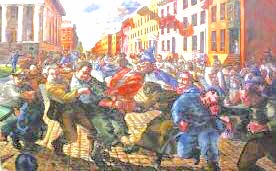“Harriet” tells the story of Harriet Tubman, who escaped from slavery in the US in 1849. It shows her bravery and heroism, as well as the work of the clandestine network known as the Underground Railroad. Tubman worked with the Underground Railroad, rescuing a total of 70 enslaved people, and leading them to freedom in the north, and, after the passage of the Fugitive Slave Act in 1850, on to Canada.
She was part of the large interracial abolitionist movement. She spoke at fundraising events, participated in at least one mass action to rescue a captured slave, and helped the militant white abolitionist John Brown plan his raid on the federal arsenal at Harpers Ferry, Virginia.
When the Civil War began, she served in the Union Army as a laundress, nurse, and a spy. In 1863 she led 150 black soldiers in a raid at Combahee Ferry, South Carolina, where they freed nearly 800 people from of slavery.
But “Harriet” is a movie.
“Harriet” is the story of an action heroine. Loyalty to and betrayal of Tubman and struggle is its theme. The filmmakers invented characters that represent generic realities to carry that narrative. They include the young white master obsessed with Tubman, the black slave hunter, and the free black woman in Philadelphia who defends Tubman with her life.
These characters, along with the real-life characters of Tubman’s family, and actual members of the Underground Railroad, illustrate the message that loyalty is not a question of family ties, but a question of political commitment to the struggle.
But what’s the struggle? Chattel slavery was only ended in the United States by a civil war. And the movie downplays that reality. On the one hand, when Tubman is trying to rescue her sister from slavery, the sister refuses to leave her children behind, saying, “Everybody can’t run.” Tubman knew that, but the movie doesn’t depict her as believing that. In a meeting with abolitionists, she is shown arguing for rescuing individuals rather than leading a movement to end slavery altogether.
And the masses, black and white, and John Brown are left out altogether.
John Brown: Tubman met Brown in 1858. A white abolitionist who had participated in violent actions against slave owners in Kansas, Brown was organizing among abolitionists for support for his raid on the Federal Arsenal at Harpers Ferry, Virginia. He hoped to seize enough guns to start a civil war.
Tubman was enthusiastic about his proposal. She gave him tactical advice in planning the raid. She also gave fundraising speeches to support it. She did not accompany him to Harpers Ferry because of her illness, but she never wavered in her support of Brown.
The Nalle Affair: In 1860, Tubman played a key role in the mass rescue of Charles Nalle, who had escaped from slavery and was imprisoned in Troy, New York. A mob of nearly four hundred abolitionists rescued Nalle from a judge’s office. This was not the only time that a mob of black and white abolitionists took the law into their own hands to rescue runaways. Tubman was not the only black woman to play a heroic role in these fights. But the movie—and history in general—only shows the pacifists and Quakers of the Underground Railroad.
So what’s the poison being pushed here?
The fight against slavery is portrayed as a “black” struggle. Loyalty is seen as loyalty to your “race’—not to your class. Whites are “allies”—not comrades in a common struggle against a system which divides us to oppress us all.
And mass, armed struggle, is only shown in the movies when it’s the US Army.
The raid at Combahee Ferry is heroic, and the one place in the movie you see masses of people, led by Tubman, liberate hundreds from slavery. And she rightly says that the Civil War could not be won without black soldiers.
But in 2019, imperialist war is on the horizon and black politicians like Kamala Harris, Cory Booker and Deval Patrick are trying to win the loyalty of black Americans. “Harriet” is finally a patriotic lie which, like “Glory” in 1989, and the NYTimes 1619 Project, attempts to win black Americans to patriotism and war.
Watch “Harriet” with a critical eye. Then read the history of the mass, interracial struggle against slavery. One place to start is our racism pamphlet: To End Racism, Mobilize the Masses for Communism at icwpredflag.org/rpe.pdf. And read Red Flag for the struggle today against racist global capitalism. Join the International Communist Workers’ Party to fight for a communist world without exploitation, racism and war.

Tubman and the rescue of Charles Nalle


